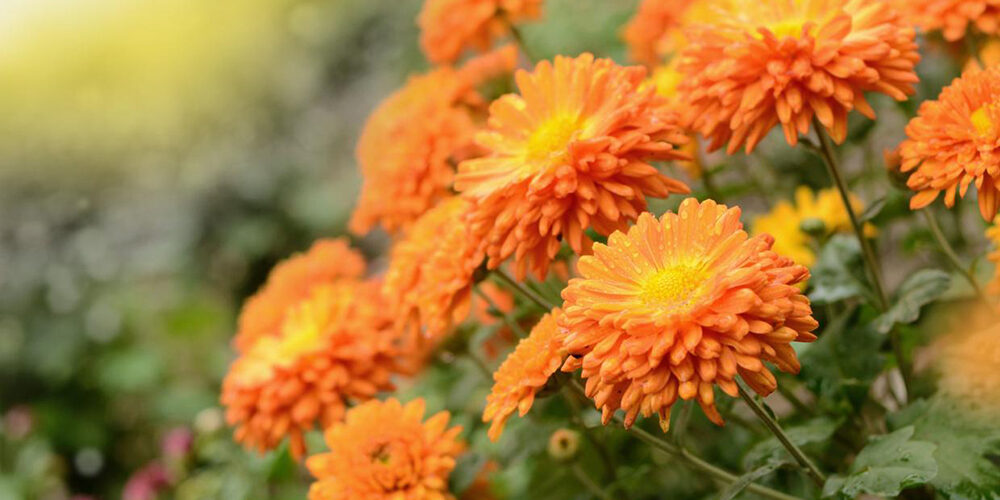Growing Chrysanthemums

Chrysanthemums or “mums” are associated with autumn, appearing in jewel colors in garden centers in September and October. However, if you are growing mums, they are hardy perennial plants best planted in the early spring. Discover how to plant, grow, and care for these colorful members of the daisy family!
What is a mum?
The Chrysanthemum is a member of the Asteraceae (Compositae) family, related to dahlias, sunflowers, marigolds, zinnias, and cosmos. Each bloom is made of hundreds of tiny flowers called florets. The plant ranges in size from a common small cushion mum to the giant spider mums, and they bloom in almost every color of the rainbow: yellow, lavender, pink, purple, red, bronze, orange, and white. They leaves are a lovely blue/green.
A brief mum history
The chrysanthemum was first cultivated in China as a flowering herb back in 15th century B.C. Based on early illustrations, it appeared as more of a daisy-like flower. Since then, the mum has been bred in so many shapes, sizes, showy styles and a multitude of colors that don’t always resemble its humble beginnings.
According to the National Chrysanthemum Society, “the genus Chrysanthemum once included more species, but was split several decades ago into several genera, putting the economically important florist chrysanthemum in the genus Dendranthema. The placement of the florist chrysanthemum in this genus was very contentious. A ruling of the International Code of Botanical Nomenclature in 1999 changed the defining species of the genus Chrysanthemum to C. indicum, giving the florist mum back its prized generic name.” The National Chrysanthemum Society divides bloom forms into 13 classes.
Decorative mums
Mums that are sold in garden centers in the autumn should be treated as annuals. They are decorative gift plants which are not bred to be hardy; it’s their color, size and form that are prized. If these plants are put in the ground in late summer, many won’t make it through the winter in cold regions.
Planting
- Mums generally grow to a width and height of 1 to 3 feet so keep this in mind when planning your garden.
- You can start mums indoors from seed 6 to 8 weeks before your last spring frost date.
- For best results, select a spot in full sun away from trees and big shrubs.
- Soil needs to be well-drained and evenly moist soil. Mums do not like standing water and will quickly rot if left too wet. Add aged manure or compost to the soil.
- Plant the mum in the ground at the same depth as it was grown in the pot.
- Plant mums 18 to 36 inches apart, depending on the mature size of the plant.
Care
- Mums are heavy feeders and should be fertilized monthly. Sprinkle a balanced fertilizer (10-10-10) around the plant.
- Maintain good air circulation around plants.
- Add mulch around the mum to conserve soil moisture and to keep weeds out.
- Soak the soil deeply when watering. Avoid getting water on the leaves.
- When new shoots reach 3 to 4 inches tall, pinch off the top leaving 2 to 3 leaves on the shoot. This will create a bushier plant. Continue pinching once a month until mid-July when flower buds develop.
- Stop fertilizing when flower buds emerge.
- Add 4 to 6 inches of mulch around the plant after the ground has frozen.
- Don’t cut back mums when tidying up flower beds in the fall. The dead growth insulates the roots. Cut off the dead stems and leaves when you see the first green shoots in the spring.
Overwintering mums
In really cold areas, overwinter the plants in the basement or in a dark cold closet.
- Pot up plants after the first frost in the fall; include as much of the roots as possible.
- Leave the foliage on the plants until spring.
- Water well and place in a totally dark 32ºF to 50ºF area.
- The plants will hibernate for the winter if you keep their roots damp.
- Check pots weekly. In the spring introduce plants gradually to light and set them out in the garden after the last killing frost.
Dividing mums
Every 2 to 3 years divide the mum when you see new growth in the spring. Using a large knife cut out the old central portion of the plant and discard. Cut the remaining portion into sections. Each section should have several shoots and a good root system. Replant these sections.
Pests/Diseases
Mums are susceptible to aphids, mites, and powdery mildew.
Recommended Varieties
There are 13 bloom classes of mums. The classes are based on flower form and petal shape.
Yellow Flowers
- ‘Jessica’: mid-season, long-lasting bright yellow flowers
- ‘Yellow Sarah’: late-blooming, yellow flowers with quilled petals
Lavender/Pink Flowers
- ‘Cabernet’: late-season, lavender flowers up to 3 inches in diameter ‘
- Tripoli’ very late-season, vibrant pink daisy-shape flowers with yellow centers
Purple Flowers
- ‘Tinkerbell’: early-season, strong\compact plant with intense purple flowers
- ‘Barbara’: late-season, small plant with purple pompon-shape flowers
Red Flowers
- ‘Ruby Mound’: early-season, maroon-red large flowers
- ‘Garnet’: mid-season, red pompon-shape flowers that mature to bronze
Bronze Flowers
- ‘Cheyenne’: mid-season, large plant with button-like texture
- ‘Denise’: very late-season, large plant with pastel bronze flowers
White Flowers
- ‘Chablis’: early-season, the white flowers have a creamy center
- ‘Patriot’: mid- to late-season, pure white pompon-shape flowers
Website: www.almanac.com